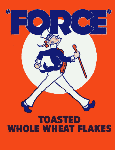Force (cereal)

Force, first produced in 1901 by Force Food Company, one of three American companies owned by Edward Ellsworth and advertised using a popular cartoon figure called Sunny Jim, was the first commercially successful wheat flake cereal. Prior to this, the only successful wheat-based cereal products had been Shredded Wheat and the hot semolina cereal, Cream of Wheat. The product was cheap to produce and kept well on store shelves.
The first advertising copy for the new product described the cereal as "The Food That is all Food", the advertising images showed rosy-cheeked children, and it was sold in a box decorated with images of muscular men wrestling with chains. Perhaps because it was not initially targeted at a well defined market, it did not sell well.
In late 1901 Minnie Maud Hanff, a freelance jingle writer, invented the character Jimmy Dumps, a morose character who on eating the cereal was transformed into Sunny Jim. Dorothy Ficken produced line drawings, and Hanff produced light hearted jingles describing Sunny Jim's transformation. The advertising appeared in magazines, on billboards, and on the sides of urban trolley cars from May 1902 through to the fall.
The campaign was wildly successful. Force was originally produced in a single plant in Buffalo, but by early 1904 the Canadian Grocer reported that there was one more Force food mill in Buffalo, a third mill in Chicago and one in Hamilton, Ontario, producing a total of 360,000 packages per day.
Ellsworth overextended and lost control of his companies in 1907. After that the Force cereal changed ownership frequently.
In 1903 a British subsidiary of the Force Food Company was formed to import the cereal to Europe. A slightly modified version of Sunny Jim and his jingles caught the fancy of British consumers. A. C. Fincken, a former employee of the Force Food Company, set up an agency in 1910 to import American cereals to the UK. The cereal, and the Sunny Jim character, achieved wide success in Britain, at its peak in 1930 selling 12.5 million packages. In 1932 the cereal was reintroduced into the United States by Herbert C. Rice, an Englishman involved in radio production in Buffalo. He introduced The H-Bar-O Rangers, a popular radio adventure serial for boys involving another permutation of the Sunny Jim character, and linked to an advertising campaign for the cereal. It didn't last.
In 1940, Force sponsored The Adventures of Superman, a radio show which introduced key concepts to Superman like Kryptonite.[1]
Since 1954, the cereal has been manufactured in the UK for domestic sale. A.C. Fincken & Co., Ltd. was sold to Rank Hovis McDougall, a subsidiary of the Nestle Company, in 1985. An unusual marketing campaign in the 1970s was focussed on the Ravenglass and Eskdale Railway: perhaps successful, but exposed to a very narrow market. A pre decimal coin collection was available with all 10 coins of ER2 including the farthing, circa 1986-88.
Manufacture of Force cereal ceased in 2013,[2] the reason cited being poor sales, although in the last few years of production the cereal had been difficult to find due to having very few suppliers, latterly only Sainsbury's, Waitrose and Ocado.
Since then, the Force wheatflakes brand was revived for UK consumers, and was acquired by Nestlé, and are for sale on the Waitrose website. [3]
References
- The Case for Sunny Jim: An Advertising Legend Revisited by Eileen Margerum in Sextant, the journal of Salem State College.
- ↑ The Golden Age of DC Comics: 365 Days by Les Daniels. Page titled September 7. ISBN 978-0-8109-4969-0
- ↑ The Grocer (website), Jan 26, 2013 (http://www.thegrocer.co.uk/fmcg/ambient/cereals/force-cereal-axed-after-112-years/235914.article")
- ↑ Waitrose Online Supermarket (UK): http://www.waitrose.com/shop/ProductView-10317-10001-9-Force+whole+wheat+flakes